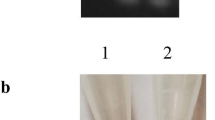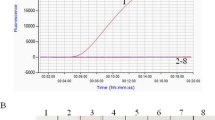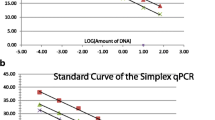Abstract
Escherichia coli O157:H7 (E. coli O157:H7) is a foodborne pathogenic microorganism that is commonly found in the environment and poses a significant threat to human health, public safety, and economic stability worldwide. Thus, early detection is essential for E. coli O157:H7 control. In recent years, a series of E. coli O157:H7 detection methods have been developed, but the sensitivity and portability of the methods still need improvement. Therefore, in this study, a rapid and efficient testing platform based on the CRISPR/Cas12a cleavage reaction was constructed. Through the integration of recombinant polymerase amplification and lateral flow chromatography, we established a dual-interpretation-mode detection platform based on CRISPR/Cas12a-derived fluorescence and lateral flow chromatography for the detection of E. coli O157:H7. For the fluorescence detection method, the limits of detection (LODs) of genomic DNA and E. coli O157:H7 were 1.8 fg/µL and 2.4 CFU/mL, respectively, within 40 min. Conversely, for the lateral flow detection method, LODs of 1.8 fg/µL and 2.4 × 102 CFU/mL were achieved for genomic DNA and E. coli O157:H7, respectively, within 45 min. This detection strategy offered higher sensitivity and lower equipment requirements than industry standards. In conclusion, the established platform showed excellent specificity and strong universality. Modifying the target gene and its primers can broaden the platform’s applicability to detect various other foodborne pathogens.





Similar content being viewed by others
References
Reissbrodt R. New chromogenic plating media for detection and enumeration of pathogenic Listeria spp.—an overview. Int J Food Microbiol. 2004;95(1):1–9.
Bai Z, Xu X, Wang C, Wang T, Sun C, Liu S, et al. A comprehensive review of detection methods for Escherichia coli O157:H7. TrAC Trends Anal Chem. 2022;152:116646.
Chen G, Yang L, Liu G, Zhu Y, Yang F, Dong X, et al. Research progress in protein microarrays: focussing on cancer research. Proteomics Clin Appl. 2023;17(1):e2200036.
Wang J, Kanach A, Han R, Applegate B. Application of bacteriophage in rapid detection of Escherichia coli in foods. Curr Opin Food Sci. 2021;39:43–50.
Jauset-Rubio M, El-Shahawi MS, Bashammakh AS, Alyoubi AO, O’Sullivan CK. Advances in aptamers-based lateral flow assays. TrAC Trends Anal Chem. 2017;97:385–98.
Gumaa MM, Cao X, Li Z, Lou Z, Zhang N, Zhang Z, et al. Establishment of a recombinase polymerase amplification (RPA) assay for the detection of Brucella spp. Infection. Mol Cell Probes. 2019;47:101434.
Li J, Macdonald J, von Stetten F. Review: a comprehensive summary of a decade development of the recombinase polymerase amplification. Analyst. 2018;144(1):31–67.
Garrido-Maestu A, Azinheiro S, Carvalho J, Fuciños P, Prado M. Development and evaluation of loop-mediated isothermal amplification, and recombinase polymerase amplification methodologies, for the detection of Listeria monocytogenes in ready-to-eat food samples. Food Control. 2018;86:27–34.
Bazsefidpar S, Serrano-Pertierra E, Gutiérrez G, Calvo AS, Matos M, Blanco-López MC. Rapid and sensitive detection of E. coli O157:H7 by lateral flow immunoassay and silver enhancement. Microchim Acta. 2023;190(7):264.
Liu H, Wang JB, Li P, Bai L, Jia JW, Pan AH, et al. Rapid detection of P–35S and T-nos in genetically modified organisms by recombinase polymerase amplification combined with a lateral flow strip. Food Control. 2020;107:106775.
Ahmed A, Rushworth JV, Hirst NA, Millner PA. Biosensors for whole-cell bacterial detection. Clin Microbiol Rev. 2014;27(3):631–46.
Tarr PI, Gordon CA, Chandler WL. Shiga-toxin-producing Escherichia coli and haemolytic uraemic syndrome. Lancet. 2005;365(9464):1073–86.
Nnachi RC, Sui N, Ke B, Luo Z, Bhalla N, He D, et al. Biosensors for rapid detection of bacterial pathogens in water, food and environment. Environ Int. 2022;166:107357.
Fu X, Sun J, Ye Y, Zhang Y, Sun X. A rapid and ultrasensitive dual detection platform based on Cas12a for simultaneous detection of virulence and resistance genes of drug-resistant Salmonella. Biosens Bioelectron. 2022;195:113682.
Acknowledgements
We thank LetPub (www.letpub.com) for its linguistic assistance during the preparation of this manuscript.
Funding
This study was supported by the Scientific and Innovative Action Plan of Shanghai (21N31900800), Shanghai Rising-Star Program (23QB1403500), Ministry of Agriculture and Rural Affairs Dairy Cluster Program (2023–2025), Shanghai Science and Technology Commission, the Belt and Road Project (20310750500), Talent Project of SAAS (2023–2025), and the SAAS Program for Excellent Research Team (2022 (B-16)).
Author information
Authors and Affiliations
Contributions
Jiawei Luo and Danhong Xu designed the study. Jiawei Luo, Danhong Xu, Hua Liu, and Jinbing Wang designed and performed the experiments and analyzed the data. Jiawei Luo, Danhong Xu, Bo Deng, Haijuan Zeng, and Xiaofeng Liu wrote and revised the manuscript. All authors read and approved the final version of the manuscript.
Corresponding authors
Ethics declarations
Conflict of interest
The authors declare no competing interests.
Additional information
Publisher's Note
Springer Nature remains neutral with regard to jurisdictional claims in published maps and institutional affiliations.
Supplementary Information
Below is the link to the electronic supplementary material.
Rights and permissions
Springer Nature or its licensor (e.g. a society or other partner) holds exclusive rights to this article under a publishing agreement with the author(s) or other rightsholder(s); author self-archiving of the accepted manuscript version of this article is solely governed by the terms of such publishing agreement and applicable law.
About this article
Cite this article
Luo, J., Xu, D., Wang, J. et al. A Dual-mode platform for the rapid detection of Escherichia coli O157:H7 based on CRISPR/Cas12a and RPA. Anal Bioanal Chem (2024). https://doi.org/10.1007/s00216-024-05301-0
Received:
Revised:
Accepted:
Published:
DOI: https://doi.org/10.1007/s00216-024-05301-0




